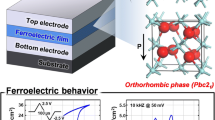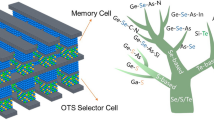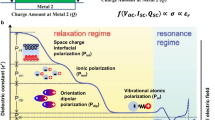Abstract
The first-principle theoretical studies about the effects of the electric field and oxygen vacancies on the structural relaxation of rutile titanium dioxide and the impacts of the relaxed structures on the capacitor-voltage curves are reported. The results show that oxygen vacancies in the same side bring more unstable bonds between oxygen atoms and titanium atoms than they do in the two sides. Titanium atoms dominate the interactions with oxygen vacancies on the unstable bonds. The unstable bonds of Ti-O would be broken at an electric field of 2.6 MV/cm. The broken bonds caused by the electric field and oxygen vacancies can form the conduction path in rutile titanium dioxide. The static dielectric constants are dependent on the dispersion of oxygen vacancies. It is concluded that the capacitor-voltage curves of Metal/TiO2/P-Si structure are dependent on the oxygen vacancies. It can help us to clarify the atom-level mechanism of the conduction path in resistive switching in resistance random-access memory.
Similar content being viewed by others
References
K.K. Adepalli, M. Kelsch, R. Merkle, J. Maier, Adv. Funct. Mater. 23, 1798 (2013)
K. Szot, M. Rogala, W. Speier, Z. Klusek, A. Besmehn, R. Waser, Nanotechnology 22, 254001 (2011)
D.H. Kwon, K.M. Kim, J.H. Jang, J.M. Jeon, M.H. Lee, G.H. Kim, X.S. Li, G.S. Park, B. Lee, S. Han, M. Kim, C.S. Hwang, Nat. Nanotechnol. 5, 148 (2010)
R. Waser, R. Dittmann, G. Staikov, K. Szot, Adv. Mater. 21, 2632 (2009)
H.D. Lee, B. Magyari-Kope, Y. Nishi, Phys. Rev. B 81, 193202 (2010)
M.F. Camellone, N.N. Nair, B. Meyer, D. Marx, Phys. Rev. Lett. 105, 146405 (2010)
A. Fujishima, T.N. Rao, D.A. Tryk, J. Photochem. Photobiol. C 1, 1 (2000)
M.D. Rasmussen, L.M. Molina, B. Hammer, J. Chem. Phys. 120, 988 (2004)
B. Delley, J. Chem. Phys. 113, 7756 (2000)
M. Janousch, G.I. Meijer, U. Staub, B. Delley, S.F. Karg, B.P. Andreasson, Adv. Mater. 19, 2232 (2007)
H.Y. Kim, H.M. Lee, G. Henkelman, J. Am. Chem. Soc. 134, 1560 (2012)
J.G. Chang, H.T. Chen, S.P. Ju, H.L. Chen, C.C. Hwang, Langmuir 26, 4813 (2010)
J.P. Perdew, K. Burke, M. Ernzerhof, Phys. Rev. Lett. 77, 3865 (1996)
H.J. Monkhorst, J.D. Pack, Phys. Rev. B 13, 5188 (1976)
R.S. Mulliken, J. Chem. Phys. 23, 1833 (2004)
M.D. Segall, R. Shah, C.J. Pickard, M.C. Payne, Phys. Rev. B 54, 16317 (1996)
L.M. Terman, Solid-state Electron. 5, 285 (1962)
K. Lehovec, A. Slobodskoy, Phys. Status Solidi 3, 447 (1963)
X. Han, G. Shao, J. Phys. Chem. C 115, 8274 (2011)
C. Lee, P. Ghosez, X. Gonze, Phys. Rev. B 50, 13379 (1994)
K.M. Glassford, J.R. Chelikowsky, Phys. Rev. B 46, 1284 (1992)
J.K. Burdett, T. Hughbanks, G.J. Miller, J.W. Richardson, J.V. Smith, J. Am. Chem. Soc. 109, 3639 (1987)
C.H. Lui, Z. Li, K.F. Mak, E. Cappelluti, T.F. Heinz, Nat. Phys. 7, 944 (2011)
Y. Zhang, T.T. Tang, C. Girit, Z. Hao, M.C. Martin, A. Zettl, M.F. Crommie, Y.R. Shen, F. Wang, Nature 459, 820 (2009)
K.F. Mak, C.H. Lui, J. Shan, T.F. Heinz, Phys. Rev. Lett. 102, 256405 (2009)
A.A. Avetisyan, B. Partoens, F.M. Peeters, Phys. Rev. B 81, 115432 (2010)
Z. Ni, Q. Liu, K. Tang, J. Zheng, J. Zhou, R. Qin, Z. Gao, D. Yu, J. Lu, Nano Lett. 12, 113 (2011)
N.D. Drummond, V. Zolyomi, V.I. Fal’Ko, Phys. Rev. B 85, 075423 (2012)
Y. Li, S.V. Rotkin, U. Ravaioli, Nano Lett. 3, 183 (2003)
N.A. Deskins, M. Dupuis, J. Phys. Chem. C 113, 346 (2008)
L.F. Mao, C. Tan, M. Xu, J. Appl. Phys. 88, 6560 (2000)
L.F. Mao, Nano. Res. Lett. 8, 1 (2013)
Author information
Authors and Affiliations
Corresponding author
Rights and permissions
About this article
Cite this article
Li, L., Li, WS., Ji, AM. et al. First-principle study on the relaxation of defected titanium dioxide under electric fields and its impacts on capacitor-voltage curves. Eur. Phys. J. B 87, 298 (2014). https://doi.org/10.1140/epjb/e2014-50476-6
Received:
Revised:
Published:
DOI: https://doi.org/10.1140/epjb/e2014-50476-6




